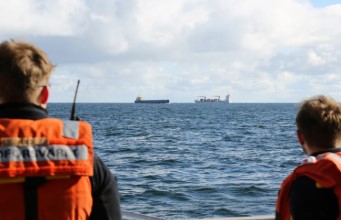The Baltic Sea has become a major area of concern for NATO. Over the past year, undersea pipelines and communication cables have been damaged, raising suspicions of sabotage. Many of these incidents involved ships dragging their anchors—some with links to Russia. In response, NATO launched Baltic Sentry, a mission dedicated to monitoring and protecting the sea’s vital infrastructure.
A New Mission to Protect the Baltic
At the heart of this mission is a fleet of at least 10 NATO-controlled ships, divided into two task groups. These ships, along with naval and coast guard vessels from eight NATO countries bordering the Baltic, work together to keep an eye on potential threats. Surveillance planes from the U.S., France, Germany, and the U.K. also take turns scanning the waters from above.
Belgian Navy Commander Erik Kockx is one of the leaders of this operation. Recently, while patrolling the Baltic on the Dutch Navy ship HNLMS Luymes, he was alerted to a suspicious ship. The vessel had just left a Russian port and had slowed down near a pipeline, raising concerns that it might be involved in sabotage. As the Luymes approached, the ship quickly regained speed and sailed away.
Rising Tensions: Latvia & NATO Bolster Baltic Security
NATO officials say that while there is no direct proof that Moscow is behind the sabotage, the pattern of suspicious activity is alarming. The presence of NATO ships acts as a deterrent, making it harder for anyone to damage critical infrastructure without being noticed.
High-Tech Surveillance and Quick Response
One of the biggest challenges NATO faces in securing the Baltic is the sheer size of the sea and the heavy traffic it carries. Every day, over 1,500 commercial ships travel through its waters, making it difficult to track every suspicious movement.
To improve monitoring, NATO has started using advanced undersea drones to inspect pipelines and cables. These drones are small but powerful, equipped with cameras and sensors that can detect disturbances on the seabed. Ships like the Luymes also use sonar technology and submersible probes to check for any signs of tampering.
Also Read About Navigation Warfare
In addition to high-tech tools, NATO is also using artificial intelligence. A new system called Mainsail analyzes ship movements in the Baltic and flags unusual behavior. This allows NATO to quickly identify ships that are acting out of the ordinary—such as slowing down near infrastructure or changing routes unexpectedly.
The operation also includes rapid response drills. Recently, a Norwegian mine-hunting ship, HNoMS Hinnoy, demonstrated its ability to react to potential threats. The Hinnoy has a unique catamaran design that allows it to sail into minefields with less risk of triggering explosions. It carries a small submarine-like drone called Minesniper and a team of divers who can inspect suspicious objects underwater.
NATO forces have also been training for possible attacks. Crews practice defensive maneuvers to protect against small boat assaults, similar to the attack on the USS Cole in 2000. During a drill, crew members fired blank rounds at a speedboat pretending to be an incoming threat. Such exercises help ensure that ships can defend themselves if they are targeted.
Portugal’s Powerful F-16 Jets Replace Costly Dutch F-35s in NATO Baltic Skies Realignment
A Complex Web of Coordination
While NATO’s presence in the Baltic has increased, the mission still faces obstacles. One major challenge has been gathering detailed information on all the pipelines and cables beneath the sea. In the past, this information was controlled by different governments and private companies, making it difficult to get a complete picture.
To address this, NATO created the Centre for Critical Undersea Infrastructure, which has assembled the first unified map of the Baltic’s seafloor. This has helped NATO patrols understand where the most vulnerable points are and focus their efforts accordingly.
However, the mission also involves navigating a complex web of authorities. Coast guards, police forces, and commercial organizations all have a stake in the security of the Baltic, meaning NATO must carefully coordinate its efforts. U.S. Army General Christopher Cavoli, who leads NATO’s forces in Europe, described it as a “complicated mix” of agencies working together.
Swedish Undersea Cable Targeted! Suspected Sabotage Sparks Baltic Sea Security Crisis
Despite these challenges, NATO has already made progress. When Baltic Sentry first began, it could take up to 17 hours for NATO to respond to suspicious activity. Now, that time has been reduced to just one hour.
Although NATO cannot monitor every inch of the Baltic, officials hope that its presence will make potential saboteurs think twice before acting. “We can’t put a ship over each mile of infrastructure,” said Danish Navy Captain Niels Markussen. “It is deterrence we are working on.”

